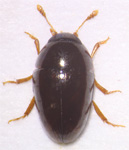Antennae 11 segmented; 1 and 2 enlarged and 9-11 forming a loose, flattened club, inserted under front margin of head in front of eyes. Entire upper surface very shiny and, in Olibrus species, distinctly metallic. Head and pronotum finely punctured. Elytra variously striate but always with one or two well impressed and incomplete sutural striae which are deepened towards the apex. Microscopically punctured between striae in most species. All our species are macropterous and at least some (in our experience) fly readily. Legs short; femora usually not visible in set specimens, protibiae with distinct terminal spines, the number and arrangement of which is sometimes diagnostic. Tarsi 5-5-5, segments 2 and 3 bilobed, 4 very small and so they appear four segmented. Most species are unicolorous black or brown although some species of Stilbus are lighter red or brown towards the elytral apices.
Identification to the generic level is straightforward but because of the sometimes wide morphological variation identification at the specific level may rely on examination of the genitalia. Distinguishing the sexes on external morphology is often not possible but in some species the male may possess an enlarged second protarsal segment, a distinctive terminal antennal segment or an emarginate anterior clypeal margin. Elytral microsculpture will sometimes need to be examined but a magnification of at least X100 and excellent lighting will be needed. The RES handbook by R.T Thompson (1958) is an excellent introduction to the family and includes keys and genitalia figures, all species on the current (2009) checklist are covered and these two works will allow the British species to be dealt with. The works of Fowler and Joy are out of date and not useful although Joy keys the groups to family and generic level very easily. The review by Vogt (1967) in German (Die Kafer Mitteleuropas,7 updated by Lohse and Lucht in Vol 13, (1992) contains excellent line drawings of male and female terminalia and various other structures is well worth the effort.
Many of our species are of widespread occurrence across southern England and may be found by general sweeping. Examining flowers, especially yellow flowers, from late May or June onwards may produce them and often in large numbers, generally among Meligethes spp etc., after a while the phalacrids become instantly recognisable in the field. Many specimens will turn up by shaking flowers into bags, the beetles sometimes lie buried deep within an inflorescence so flowers that seem initially devoid of specimens may give good results. Several species are common or abundant throughout our area and we occasionally record them at MV in town centre gardens.
| 1. | Elytra with two striae adjacent to suture, well developed in apical half and deepened towards apex. Antennal club 'loose' with last segment constricted before apex so that the sides are sinuate. Body at least to some degree metallic. | Olibrus |
| -- | Elytra with a single sutural stria. Sides of last antennal segment smoothly curved to a rounded apex, not sinuate. Body not metallic. | 2. |
| 2. | Entirely black, tarsi sometimes lighter; reddish or brown. Antennal club 'loose'. | Phalacrus |
| -- | To some extent reddish, at least towards apex of elytra, if entirely black then appendages wholly pale; yellow or brown. Antennal club compact. | Stilbus |
Examination of the elytral microsculpture is essential to separate our three British species of Stilbus. This needs to be done at high magnification, X100 or more, and in strong and diffuse light. In S.oblongus (Erichson) this is reticulate, comprising irregular but overall isodiametric pentagons, hexagons or quadrilaterals which are rarely fused to form elongate cells within the pattern. In S.testaceous (Panz.) the microsculpture comprises wavy transverse lines which occasionally merge but are not cross-linked and do not form cells. In S.atomarius (L.) the microsculpture is a hybrid form; reticulate but interspersed with continuous transverse lines and open transverse cells. These are figured as line drawings in Thompson.
Line drawings of the aedeagi of all three species are featured by Thompson as is the prosternal process which is a good character for separating oblongus from testaceous and atomarius; in oblongus this has 4 or 5 small (difficult to appreciate) setae along the (truncate) apex whereas in teastaceous and atomarius there are betwen 4 and 8.
Vogt's (1967) treatment includes only these three species and follows Thompson's key, including also reproductions of his line drawings.
Joy's key relies on shape (including convexity), colour and size; testaceous is quoted as 1.8-2.4mm while oblongus and atomarius are 1.5-1.8mm. Differences in shape and convexity are very subtle and possibly meaningless without experience, the size range of each species given by both Thompson and Vogt is virtually the same. This Joy key should, therefore, not be relied on.
Reference
Vogt, H. 1967 In Freude, H et al. Die Kafer Das Mitteleuropas 7 158-166
Five species of Phalacrus are included on our British list (Duff, 2008) and are all keyed by Thompson (1958) who gives splendid line drawings of the antennae (P.fimetarius being very distinctive) and ovipositors (which need to be carefully slide mounted) of each. In this work use is made of the number and arrangement of spines on the outer edge of the protibiae; in the case of fimetarius (and more especially so in combination with the form of the antennae) this character renders identification straightforward at X60.
All species are keyed by Vogt (1967) (who uses the name brisouti Rye - from the form of the antennae this is our fimetarius (Fab.)) who also includes line drawings of the aedeagi.
Joy's key includes four species which are keyed (among other things) on subtle differences in outline. It is difficult to use with any confidence and introduces nomenclature difficulties eg his fimetarius is now accepted as P.coriscus Panz. This key is best ignored.
Reference
Vogt, H. 1967 In Freude, H et al. Die Kafer Das Mitteleuropas 7 158-166
Olibrus
aeneus
Olibrus
corticalis
Olibrus
corticalis

Olibrus
flavicornis
Olibrus
flavicornis
Phalacrus
fimetarius
Stilbus
testaceus
Stilbus
testaceus
Home